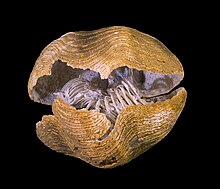Lophophore


The lophophore is the characteristic feeding organ of four major groups of animals: the Brachiopoda, Bryozoa, Entoprocta, and Phoronida.[1] All lophophores are found in aquatic organisms.
Characteristics[change | change source]
It can most easily be described as a ring of ciliated tentacles surrounding the mouth. It is often horseshoe-shaped or coiled. Phoronids have their lophophores in plain view, but the valves of brachiopods must be opened wide to get a good view of their lophophore.
The lophophore surrounds the mouth and is an upstream collecting system for suspension feeding. The gut is U-shaped with the anterior mouth at the center of the lophophore. The anus, where present, is also anterior, and is above the mouth. In the Bryozoa it is outside the ring of the lophophore; in the Entoprocta the anus is within the ring of the lophophore. Some brachiopods do not have an anus.
References[change | change source]
- ↑ Introduction to the Lophotrochozoa - accessed 03 May 2010
